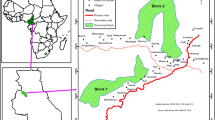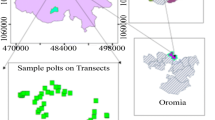Abstract
The present study aimed to assess the potential role of desert tree plantations for biodiversity conservation of native vegetation. For this purpose, we compared diversity and composition of understory vegetation in a managed desert plantation in Egypt with adjacent natural vegetation. In 126 stands, we estimated the diversity indices of the understory vegetation associated with five tree plantations inside and outside the forest. The results showed that therophytes had the highest contribution to the total flora of the study area (45.7 %), followed by chamaephytes (21.7 %). The weed species were the main components inside the forest (37 species). In the stands of Eucalyptus camaldulensis and Khaya senegalensis, the agricultural weeds were the most abundant followed by natural weeds. Spring season was the main flourishing season for weeds followed by autumn. Dalbergia sissoo had the highest values for species richness (8.8) and the lowest for species turnover (2.5). On the contrary, Casuarina spp. had the lowest values of species richness (3.0) and the highest of species turnover (7.3) and Simpson index (12.3). Establishment of the forest leads to remarkable loss and changes in the biodiversity of natural desert vegetation and vegetation composition, respectively. Many ruderal weeds colonized the adjacent desert habitats. From this study, we concluded that forest managers should pay attention for the conservation and retention of existing native vegetation during their design for the desert plantations.



Similar content being viewed by others
References
Allen SE (1989) Chemical analysis of ecological materials. Blackwell Scientific, London
Alrababah MA, Alhamad MA, Suwaileh A, Al-Gharaibeh M (2007) Biodiversity of semi-arid Mediterranean grasslands: impact of grazing and afforestation. Appl Veg Sci 10:257–264
Ayyad MA, Ghabbour SI (1986) Hot deserts of Egypt and the Sudan. In: Evenari M, Noy-Meir I, Goodall DW (eds) Ecosystems of the world-12B, hot deserts and arid shrublands. Elsevier, Amsterdam
Balvanera P et al (2006) Quantifying the evidence for biodiversity effects on ecosystem functioning and services. Ecol Lett 9(10):1146–1156
Belaid N, Neel C, Lenain JF, Buzier R, Kallel M, Ayoub T, Ayadi A, Bauduc M (2012) Assessment of metal accumulation in calcareous soil and forage crops subjected to long-term irrigation using treated wastewater: case of El Hajeb-Sfax, Tunisia. Agric Ecosyst Environ 158:83–93
Boulos L (2009) Flora of Egypt checklist. Al-Hadara, Cairo
Bremer LL, Farley KA (2010) Does plantation forestry restore biodiversity or create green deserts? A synthesis of the effects of land-use transitions on plant species richness. Biodivers Conserv 19:3893–3915
Brockerhoff EG, Jactel H, Parrotta JA, Quine CP, Sayer J (2008) Plantation forests and biodiversity: oxymoron or opportunity? Biodivers Conserv 17:925–995
Buscardo E, Smith GF, Kelly DL, Freitas H, Iremonger S, Mitchell FJG, O’Donoghue S, Mckee AM (2008) The early effects of afforestation on biodiversity of grasslands in Ireland. Biodivers Conserv 17:1057–1072
Calviño-Cancela M, Rubido-Bará M, Van Etten EJB (2012) Do eucalypt plantations provide habitat for native forest biodiversity? Forest Ecol Manag 270:153–162
Carnus JM, Parrotta J, Brockerhoff E, Arbez M, Jactel H, Kremer A, Lamb D, O’Hara K, Walters B (2006) Planted forests and biodiversity. J For 104:65–77
Dobson AP, Bradshaw AD, Baker JM (1997) Hopes for the future: restoration ecology and conservation biology. Science 227:515–552
Dupuy JM, Chazdon RL (2008) Interacting effects of canopy gap, understorey vegetation and leaf litter on tree seedling recruitment and composition in tropical secondary forests. Forest Ecol Manag 255:3716–3725
El-Khawas SA, Shehata MM (2005) The allelopathic potentialities of Acacia nilotica and Eucalyptus rostrata on monocot (Zea mays L.) and dicot (Phaseolus vulgaris L.) plants. Biotechnology 4:23–34
FAO (2006) Global Forest Resources Assessment 2005—Progress towards sustainable forest management. FAO Forestry Paper 147, Food and Agriculture Organization of the United Nations, Rome, Italy
FAO (2010) Global forest resources assessment. FAO, Rome
Farahat E, Linderholm HW (2012) Ecological impacts of desert plantation forests on biodiversity. Afr J Ecol 50:308–318
Farahat E, Linderholm HW (2013) Effects of treated wastewater irrigation on size-structure, biochemical products and mineral content of native medicinal shrubs. Ecol Eng 60:235–241
Farahat E, Linderholm HW (2015a) Nutrient resorption efficiency and proficiency in economic wood trees irrigated by treated wastewater in desert planted forests. Agric Water Manag 155:67–75
Farahat E, Linderholm HW (2015b) effect of long-term wastewater irrigation on accumulation and transfer of heavy metals in Cupressus sempervirens leaves and adjacent soils. Sci Total Environ 512–513:1–7
Gallardo-Cruz JA, Meave JA, Pérez-García EA, Hernández-Stefanoni JL (2010) Spatial structure of plant communities in a complex tropical landscape: implications for ß-diversity. Community Ecol 11:202–210
Hartley MJ (2002) Rationale and methods for conserving biodiversity in plantation forests. Forest Ecol Manage 155:81–95
Hill MO (1979) DECORANA—a FORTRAN program for detrended correspondence analysis and reciprocal averaging. Cornell University, Ithaca, p 90
Kanowski J, Catterall CP, Wardell-Johnson GW, Proctor H, Reis T (2003) Development of forest structure on cleared rainforest land in eastern Australia under different styles of reforestation. Forest Ecol Manag 183:265–280
Lambin EF, Geist HJ (2006) Land-use and land-cover change: local processes and global impacts (global change—the IGBP series). Springer, Berlin, Heidelberg, New York
Lantschner M, Rusch V, Peyrou C (2008) Bird assemblages in pine plantations replacing native ecosystems in NW Patagonia. Biodivers Conserv 17:969–989
Maff R (1986) The analysis of agricultural materials, 3rd edn. HMSO, London, p 427
Magurran AE (1988) Ecological diversity and its measurements. Princeton University Press, Princeton
Makino S, Goto H, Hasegawa M, Okabe K, Tanaka H, Inoue T, Okochi I (2007) Degradation of longicorn beetle (Coleoptera, Cerambycidae, Disteniidae) fauna caused by conversion from broad-leaved to manmade conifer stands of Cryptomeria japonica (Taxodiaceae) in central Japan. Ecol Res 22:372–381
MCPFE (2003) Improved pan-European indicators for sustainable forest management as adopted by the MCPFE Expert Level Meeting. In: Ministerial Conference on the Protection of Forests in Europe, Vienna
MESA (Ministry of State for Environmental Affairs) 2009. Annual reports. http://www.eeaa.gov.eg/English/main/about.asp. Accessed June 2011
Mölder A, Bernhardt-Römermann M, Schmidt W (2008) Herb-layer diversity in deciduous forests: raised by tree richness or beaten by beech? Forest Ecol Manag 256:272–281
Mueller-Dombois D, Ellenberg H (1974) Aims and methods of vegetation ecology. Wiley, New York
Pawson SM, Brin A, Brockerhoff EG, Lamb D, Payn TW, Paquette A, Parrotta JA (2013) Plantation forests, climate change and biodiversity. Biodivers Conserv 22:1203–1227
Pedrero F, Allende A, Gil MI, Alarcón JJ (2012) Soil chemical properties, leaf mineral status and crop production in a lemon tree orchard irrigated with two types of wastewater Francisco. Agri Water Manag 109:54–60
Pielou EC (1975) Ecological diversity. Wiley, New York, p 165
Richardson DM, Van Wilgen BW (2004) Invasive alien plants in South Africa: how well do we understand the ecological impacts? S Afr J Sci 100:45C52
Sadek HS, Abdelhadi HM, Soliman SA (1993) Nuclear materials authority, Egypt ABSTRACT. An Application of True Resistivity Contour Sections in Groundwater Exploration (A Case History). J KAU Eartt Sci 6:35–4S (14 l.1 A. 11./1993 A.D.)
Said R (1962) The geology of Egypt. Elsevier, Amsterdam, p 377
SDR (1997) Species diversity and richness v. 2.3 software. PISCES Conservation Ltd., UK
Shaltout KH, El Fahar RA (1991) Diversity and phenology of weed communities in the Nile Delta region. J Veg Sci 2:385–390
Shaltout KH, El-Sheikh MA (2002) Vegetation of the urban habitats in the Nile Delta region, Egypt. Urban Ecosyst 6:205–221
Täckholm V (1974) Students’ flora of Egypt, 2nd edn. Cairo University Press, Cairo, p 888
Thomas CD, Cameron A, Green RE, Bakkenes M, Beaumont LJ, Collingham YC, Erasmus BFN, De Siqueira MF, Grainger A, Hannah L, Hughes L, Huntley B, Van Jaarsveld AS, Midgley GF, Miles L, Ortega-Huerta MA, Peterson AT, Phillips OL, Williams SE (2004) Extinction risk from climate change. Nature 427(6970):145–148. doi:10.1038/nature02121
Turnbull JW (1999) Eucalypt plantations. New Forest 17:37–52
Whitaker GH (1972) Evolution and measurements of species diversity. Taxon 21:213–251
Zhang C, Fu S (2009) Allelopathic effects of eucalyptus and the establishment of mixed stands of Eucalyptus and native species. Forest Ecol Manage 258:1391–1396
Author information
Authors and Affiliations
Corresponding author
Rights and permissions
About this article
Cite this article
Shaltout, K.H., Farahat, E.A. & Shalapy, A.I. Effect of a desert planted forest on the understory plant diversity: implication to conservation. Rend. Fis. Acc. Lincei 27, 711–719 (2016). https://doi.org/10.1007/s12210-016-0553-3
Received:
Accepted:
Published:
Issue Date:
DOI: https://doi.org/10.1007/s12210-016-0553-3




